In my quest to make all the butterscotch things, I have now made this truly spectacular butterscotch cake with butterscotch icing.
Based on a traditional Southern caramel cake, this version substitutes a portion of white sugar for dark brown sugar and uses an icing that is really nothing more than rich butterscotch sauce poured over the top.
Basically, we’re talking about pouring candy on top of brown sugar yellow cake. It is incredibly good, and I really hope you give it a try!
Another butterscotch recipe you might like is my easy butterscotch sheetcake.
Find my other butterscotch recipes all in one place. Thanks for stopping by!
NOTE: The video doesn’t show making this cake, but it does show how to make the butterscotch, and that’s the trickiest part.
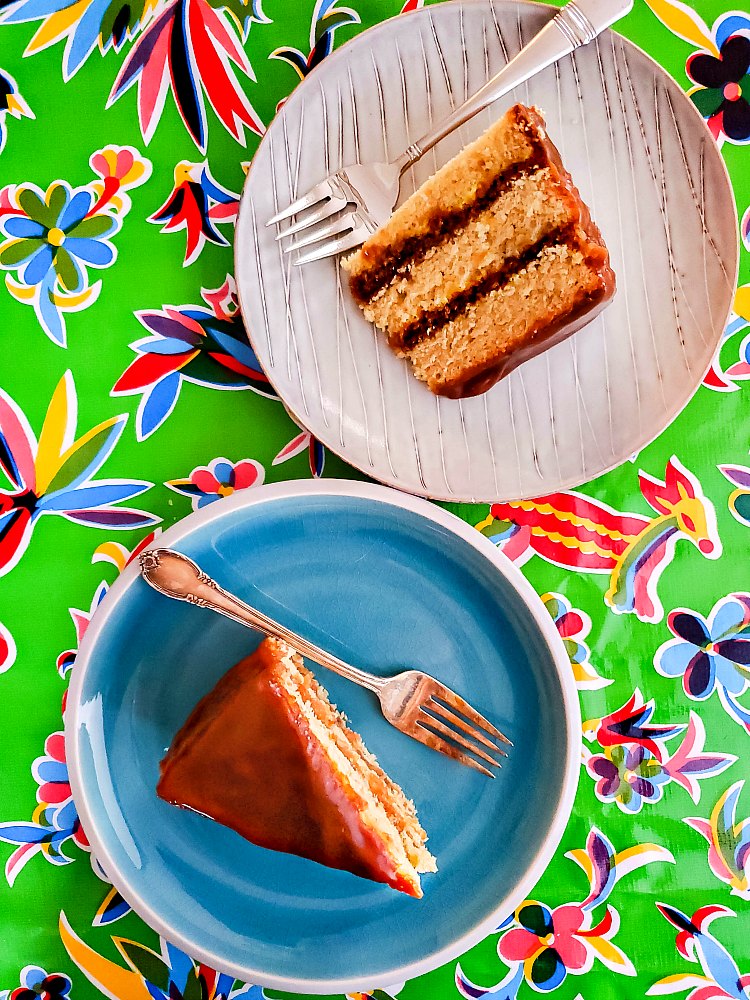
Icing vs Frosting. What’s the Difference?
I grew up using the two terms “icing” and “frosting” pretty much interchangeably. But there actually is a difference between the two.
Also, between icing and frosting, I’m betting that icing has been around a lot longer than frosting.
An icing is generally a poured cake covering. Think royal icing, powdered sugar glazes, etc.
Pastry Chef Online Participates in Affiliate Programs. If you make a purchase through one of my links, I may earn a small commission. For more information click to read my disclosure policy
Frosting generally has air whipped into it and is of a spreadable consistency. And that’s why I think it’s a newer form of cake covering: it’s easier to make things fluffy with some mechanical advantage such as a whisk, a hand mixer, or a
If you’d like a fluffy option for frosting this cake, try my fluffy caramel frosting. No, it’s not butterscotch, but it is super good!
This cake is definitely iced with what I’d call butterscotch icing rather than frosting. It’s a smooth, slick of butterscotch sauce, and it is The Best.
Caution
NOTE: Please take care in making the icing. If you burn the sugar as you’re making your butterscotch, start over.
Keep a close eye on it and add the cream right when it begins to smoke just a tiny bit and smells like caramelized sugar.
Why Is It Called Butterscotch?
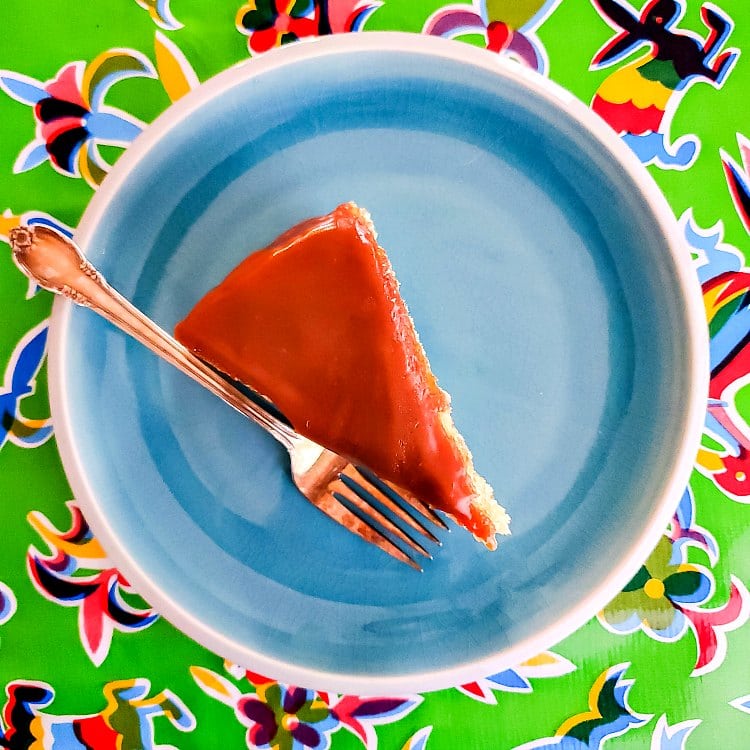
There are a couple schools of thought about why butterscotch is called butterscotch. Nobody knows for sure.
Camp One thinks that the “scotch” part refers to scoring the candy before it hardens.
Before butterscotch was a flavor or an adjective describing the flavor of something else (pudding, creme brulee, sauce, etc), it was a hard candy.
If you don’t score butterscotch hard candy before it cools all the way, it is almost impossible to break–I know! So this answer is a pretty safe bet.
On the other hand, Camp Two thinks that the term literally means to scorch the butter, and browned butter is a part of the flavor profile.
At the end of the day, I honestly don’t care where the name came from. I am just adamant that, if you’re going to call a recipe “butterscotch,” it must contain both brown sugar and butter, ideally caramelized and browned, respectively.
And you’ll get that in spades with the icing for this cake.
What You’ll Need to Make This Cake
Cakes, this one included, are usually made from simple ingredients. It’s how you put them together that counts.
Raise you hand if you have all the ingredients you need to make this cake right now!
- all purpose flour
- granulated sugar
- dark brown sugar
- salt
- baking powder
- baking soda
- butter
- whole milk
- large eggs
- vanilla extract
- heavy cream
It’s also a good idea to have a nice, heavy bottomed saucepan for butterscotch (and other candy) making as well as 8″ cake pans. You can make this cake with a hand mixer, but a
How to Make This Butterscotch Cake
- Make the Golden Yellow Cake You’ll notice that the procedure for making the cake differs from the usual “cream butter and sugar together until light and fluffy” creaming method.
This cake uses the two-stage method which results in a very tender, melt-in-your-mouth cake with a tight, velvety crumb. You can use the creaming method if you’d like, but the texture and flavor (believe it or not) will be slightly different. - Bake the cakes, let cool, and cut off any domed tops. Since we’re icing this cake and not frosting it, you want the smoothest, flattest surface possible, because you can’t hide imperfections behind a thick layer of fluffy frosting.
Use a serrated knife to cut off any domed tops so you have nice flat layers. Save the scraps as the chef’s treat, or make cake pops. - Make the Icing First, you’ll make the butterscotch as described above. Then you’ll add the heavy cream once the sugar has caramelized.
Cook this to 237F and then allow to cool for 20-30 minutes, stirring slowly occasionally so you don’t create bubbles. - Set a cooling rack over a tray. Since you’re glazing the cake, a lot will drip down off the sides. Make sure you’re icing/glazing on a rack set over a rimmed tray to catch the excess icing.
- Ice the cake. Once the butterscotch has cooled down some and thickened to a nice, pourable consistency, fill and ice the cake.
Pour on about 2/3 cup of glaze in the center of a layer and spread almost to the edges with an offset spatula.
Place the second layer on top of the first and repeat the icing. Once you have the third layer on top, carefully and slowly pour your icing across the top and down the sides of the cake.
Use a small offset spatula to add extra icing to any spots you may miss.
- Embrace imperfections. Know that you will never have a completely smooth cake. It’s not that kind of cake.
You can get the top nice and smooth and shiny, but the sides are another story. It’s okay. It will be incredibly delicious, and you don’t want more than a thin coating of butterscotch or it will overpower the more delicate flavor of the cake.
This butterscotch cake is perfect in its imperfections. You’re going to love it.
Butterscotch Cake Q & A
Butterscotch = brown sugar + butter, ideally cooked together for a long time. Pudding mix doesn’t contain either of those two ingredients, so it is not “real” butterscotch.
I prefer to use a portion of brown sugar and the butter in the cake bring a light butterscotch flavor while leaving the intense goodness to the icing.
While very similar in appearance to traditional Southern caramel cake, this cake is definitely carries butterscotch flavor and not caramel flavor.
You could, but I think the intensely butterscotch flavor–and beautiful, shiny top–of this icing is the way to go.
If you want to make frosting instead, Consider making and cooling butterscotch sauce (brown sugar, butter, salt, heavy cream–see the cake recipe) and then pouring it slowly into cream as you whip it.
This will give you a true butterscotch flavor in a fluffy, spreadable texture without adding a lot of extra richness the cake really doesn’t need. If you go this route, you’ll definitely want to store any leftover cake in the fridge and let it come to room temperature before serving.
Credit Where Credit is Due
The base of my butterscotch cake recipe is the golden yellow cake from one of my favorite dessert websites, Chocolate, Chocolate, and More. My friend Joan developed the recipe. After she passed away, her sister made and posted the cake on the site. I’m honored Gail let me play with Joan’s cake recipe.
Note I modified the procedure just slightly and substituted brown sugar for one fourth of the granulated sugar in the original recipe. Otherwise, this cake is all Joan.
And for the frosting, I used Jocelyn Adams’ (Grandbaby Cakes) recipe for the icing on her Real Deal Southern Caramel Cake as my template.
You will see I modified it by increasing the butter and salt, using dark brown sugar rather than granulated sugar, and substituting heavy cream for the evaporated milk.
A Note of Caution When Making the Icing
I’ve cautioned you once, but I’m doing it again.
A reader recently commented that they made this cake and the butterscotch icing was terrible and tasted burned so they had to throw the whole cake away.
Please, please, if you follow your nose and the butterscotch tastes burnt, don’t pour it on your cake. Start again.
Making butterscotch is not difficult, but if you have not worked with caramelizing sugar before, it can be a bit tricky.
The sugar and butter mixture can go from beautifully caramelized to burnt in no time at all, so watch it closely.
When you see the first wisps of smoke and smell a hint of caramel, it is done.
Immediately remove the pan from the heat and start whisking in the cream.
Cake and
Often, a small slice of this rich cake is all you need for dessert, but for special occasions, consider making and serving it with this butterscotch ice cream. Or butterscotch ripple ice cream. Because if you’re a butterscotch lover, you can’t really ever get enough!
Have you ever made beaten coffee? If you haven’t, I’m here to tell you you should! Whip up a cup and sweeten it with this butterscotch coffee syrup for a match made in heaven.
More Old-Fashioned Cake Recipes
If you’re looking for more old fashioned cake recipes, I have gathered a few you might really enjoy.
- Nancie McDermott’s Grandmother’s Coconut Cake old school southern goodness. Nancie knows what is up, and this cake is a real winner
- 1-2-3-4 Cake is what I consider to be the best birthday cake cake recipe. As a bonus, the formula is very easy to remember.
- Moravian Sugar Cake a yeasted coffee cake from the Moravian tradition in and around Bethlehem, PA and Winston-Salem, NC. It’s the cake I cannot stop eating.
- Chocolate Mayonnaise Cake is a vintage recipe that gets its moist goodness from mayonnaise and its deep chocolatiness from cocoa and coffee. I iced this one with chocolate icing with toasted nuts and mini marshmallows for a rocky road effect
- Red Velvet Cake with Original Ermine Frosting another super old school southern recipe, this stunning red cake with white icing is gorgeous for Valentine’s day or for Christmas.
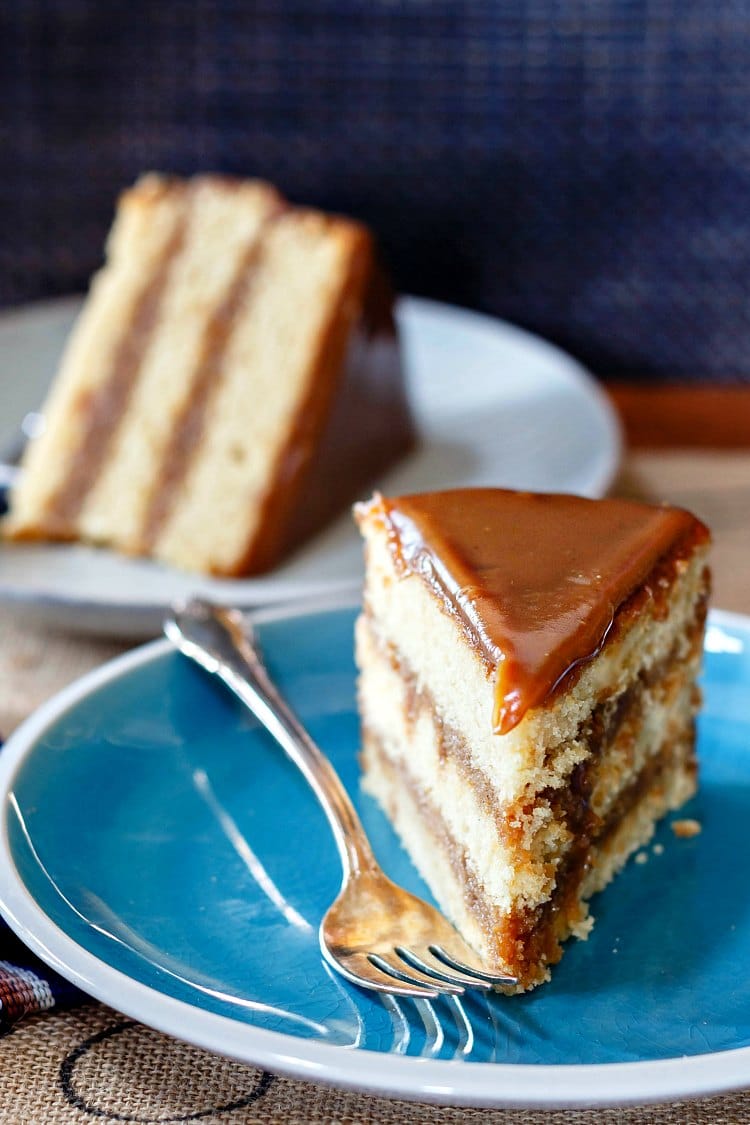
Don't let its small price and small size fool you. The Escali Primo is an accurate and easy-to-use food scale that I have used for years. It's easy to store, easy to use, has a tare function, and easily switches between grams and ounces/pounds for accurate measurements.
It will help me and other readers so much if you take a moment to rate and leave a review for this recipe.
You can use the stars to rate 1-5 (5 is best), and leave a review in the comments. It helps me make adjustments if any are needed, and comments help others decide whether the recipe is worth making.
Other ways to share include pinning, and/or sharing on your favorite social media platform.
Thank you so much for taking the time!

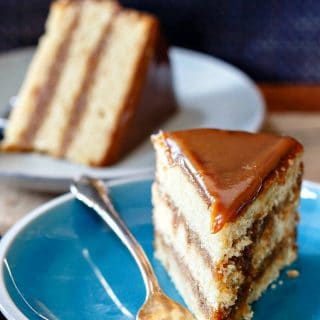
Irresistible Butterscotch Cake
Equipment
Ingredients
For the Cake
- 1 ½ cups 10.5 oz by weight granulated sugar
- ½ cup 4 oz by weight dark brown sugar, packed
- 3 ¼ cup 14 oz by weight all purpose flour (See Note 1)
- 1 Tablespoon baking powder
- 1 teaspoon fine sea salt
- ⅛ teaspoon baking soda
- ¾ cup 1 1/2 sticks or 6 oz by weight unsalted butter, soft but not melted
- 1 ¼ cup 10 oz by weight whole milk, room temperature, divided use
- 4 large eggs
- 2 teaspoons vanilla extract
For the Butterscotch Icing
- 2 sticks 8 oz by weight unsalted butter
- 2 cups 16 oz by weight dark brown sugar, packed
- 3/4-1 teaspoon fine sea salt depending on how salty you like your butterscotch
- 2 ½ cups 20 oz by weight heavy cream
Instructions
For the Cake
- Line 3 8" cake pans (See Note 2) with parchment paper and spray the sides of the pan with pan spray.
- Set your oven rack in the center of the oven and preheat to 350F.
- In a large bowl, or in the bowl of your stand mixer, add all the dry ingredients and whisk together thoroughly.
- In a medium bowl, whisk together 1/4 cup of the milk, the eggs, and the vanilla.
- Add the softened butter and the milk egg mixture to your mixing bowl. Mix on low speed to moisten the ingredients, then increase the speed to medium and beat for two minutes to develop the structure of the batter.
- Mix in the remainder of the milk just until smoothly combined.
- Divide the batter evenly among the three pans. If weighing, you should have about 17 oz of batter per cake pan. Smooth the top of the batter and bake until well risen, deeply golden brown and just barely starting to pull away from the sides of the pan. If you have an instant read thermometer, you’re looking for an internal temperature of 195F-200F. This will take between 25-30 minutes, depending on your oven. Start checking at 20-22 minutes just to be safe.
- Remove to racks to cool for 15 minutes.
- Run a thin spatula around the inside of each cake pan and then turn the cakes out on cooling racks to cool completely.
- Optional: You can wrap each cake layer in plastic wrap as soon as you turn them out. This makes sure that all the moisture that would otherwise evaporate out of the cake stays inside. This will give you the moistest possible cake.
For the Butterscotch Icing
- Melt the butter over medium heat.
- Add the dark brown sugar and salt. Whisk constantly over medium-high heat until the butterscotch is smooth and boiling.
- Keep whisking. It will go through a phase where the butterscotch gets kind of sloppy looking. The butter will separate out and you will think something has Gone Wrong. Keep whisking and cooking.
- The butterscotch will come back together. When it comes back together, continue whisking until you see some smoke coming off the butterscotch and you smell a caramelized sugar smell.
- Carefully whisk in the cream, a bit at a time, until it’s all in. The butterscotch will hiss and spit and may seize up. That’s okay. continue whisking over medium-low heat until all of the butterscotch has melted back into to cream, and then cook, whisking frequently, until it reaches 237F.
- Remove from the heat and strain into a large pitcher or bowl.
- Allow to cool and thicken a bit for about 30 minutes before icing your cake.
To Ice the Cake
- When ready to ice your cake, place a rack over a rimmed baking sheet. Use a long serrated knife to slice off the domes from your cake layers. Save for snacking or to make butterscotch cake pops.
- Place one layer of cake on an 8" cake board (or a piece of cardboard you cut to 8" and wrap in foil) and put on the rack over the baking sheet.
- Pour or ladle on about 2/3 cup of icing and spread to the edge with an offset spatula.
- Add the second layer and repeat with another 2/3 cup of icing.
- Place the last layer, bottom side up, on top and press gently so all the layers adhere.
- Pour a generous amount of icing over the top of the cake, starting in the middle and then working out to the edges, allowing it to run down over the sides of the cake. Ideally you will get complete coverage doing this. If not, you can use an offset spatula to scoop up some excess from the tray and do any patching that is necessary. Do take care to cover the top completely and smoothly. The sides are not as important, especially once you slice it.
- Allow the cake and icing to sit at room temperature until completely cool (remember, your icing is still warm when you pour it), at least two hours.
- Use two large spatulas or a cake shovel to move the iced cake off the rack and onto your serving tray.
- Cake will stay fresh for 2-3 days before cutting. Once you slice it, store the cake, covered, at room temperature for 3-4 days.
Did You Make Any Changes?
Video
Notes
- If you are not using a scale, please measure your flour by whisking it well, lightly spooning it into your measuring cup and the sweeping off the excess with a straight edge. If you scoop the flour into the cup, it will be too much and you’ll end up with a heavy cake.
- If you only have 2 cake pans, you can bake 1/3 in one cake pan and 2/3 in an 8″ x 3″ pan. This is not ideal as one cake will bake more quickly. Once cooled, use a serrated blade to cut the thicker cake in half horizontally then proceed with the recipe.
- The video for this post is not for making this cake, but it does very clearly show how to make the butterscotch, and that’s the trickiest part of the recipe. Enjoy!
Nutrition
And there you have it, friends. This is one spectacular cake, and everyone who has tried it kind of just moans with pleasure. So, yeah, I think you might need to make this butterscotch cake and the butterscotch icing that goes with it!

Hi, y’all! I hope you’ve enjoyed this post and hopefully also learned a thing or two.
If you like my style, I invite you to sign up for my occasional newsletter, The Inbox Pastry Chef.
Expect updates on new and tasty recipes as well as a bit of behind-the-scenes action. I hope to see you there!
Thanks for spending some time with me today. Take care, and have a lovely day.



Join in Today!
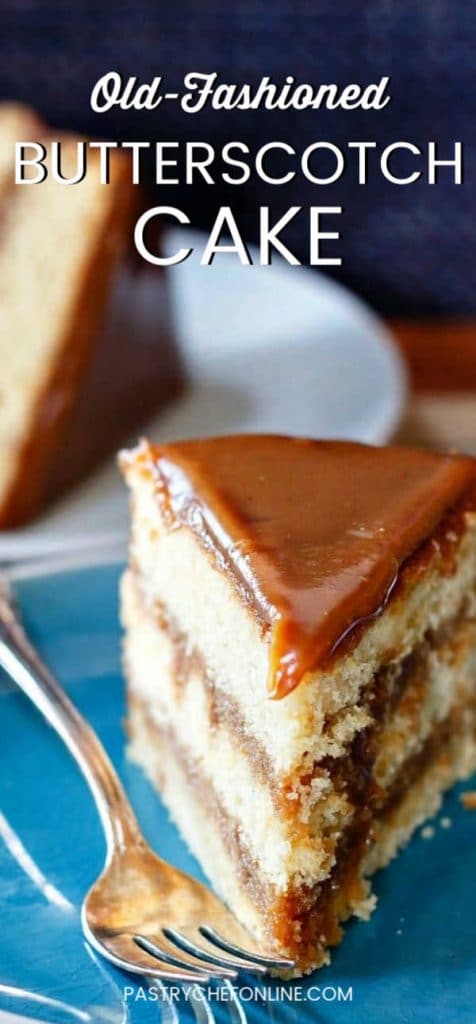
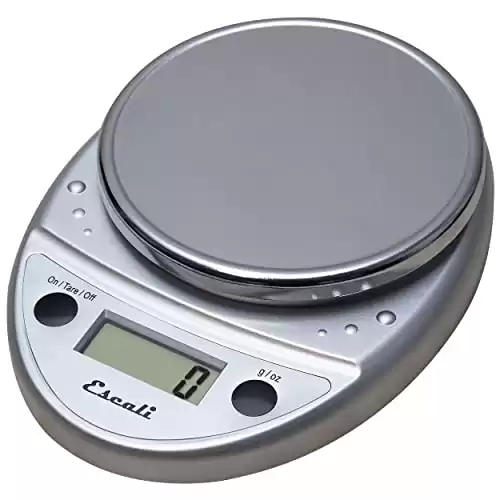
Nice and perfect recipe for butterscotch cake
thanks for sharing
I love your recipe and prepare Butterscotch cake with butterscotch icing on my birthday by my own and serve my family member and spread sweetness.
How wonderful! So glad you enjoyed it!
Thank you for sharing this delightfully easy, mouthwateringly delicious recipe. Have baked this cake several times since I first tried it a few weeks back and it’s been a huge success each time!
I’m glad you’ve enjoyed it, Ronak! Thanks for letting me know!
Can we half the recipe if we need less servings and also what should i do with one cake pan
Hey, Ar. Both good questions. I’m going to recommend you save this cake for better times and more pans! I have another butterscotch cake that is every bit as tasty, a little less fussy to make, and easily cut in half. https://pastrychefonline.com/butterscotch-sheet-cake/ If you’d still like to use the butterscotch icing from this recipe, that can easily be cut in half or thirds. Take care and be safe.
How long can I store the butterscotch sauce??
Storing the extra, or storing it before topping the cake? I would pour it on the cake as soon as it is cool but still pour able. If you make it ahead, it should be fine in the fridge for a good 3-4 weeks. Rewarm to pour over the cake. Hope that helps, and I hope you enjoy it!
Can we use normal whipping cream if not heavy
Yes you can. You may need to let the icing cook a little longer once the cream is in so you can get it to the correct consistency, but it should not make too much difference. 🙂
Can we half the recipe
Half the recipe for the cake? Or for the frosting? Or both?
You could try it and bake maybe in a loaf pan to make a layered loaf cake, or perhaps in 6″ pans. But since I have not done that, I can’t say for sure.
I will say that, with the icing since it’s poured, it does make more than you need so you can be sure to get the sides completely coated. You could half the icing recipe if you only want to cover the top and don’t mind just drips down the side. It all depends on your aesthetic.
Thanks for the question, Ariba. 🙂
The cake was good but the icing made the whole thing taste awful. It was burnt, and left a terrible taste in my mouth. It was so bad that I threw the whole thing out and never even let my guests see the thing. I cooked it until it smoked and then cooked it until it reached 237 as instructed.
Hi, Mary. It sounds like the butterscotch burned before you added any of the other ingredients. Working with sugar–especially with brown sugar that has molasses (impurities) in it–is a bit tricky. I tried to give every indicator of how to tell when it is ready, but sugar can go from caramelized to burnt in a 1/2 second. I should specify just a tiny bit of smoke rather than a lot. Follow your nose. If it smells burnt it probably is, and it’s best to just cut your losses and start with fresh butter and brown sugar rather than forging ahead. I do hope you give it another try some other time, and I’m sorry you were not able to serve it to your guests.
I had the same problem happen, the cake tasted amazing, and the icing had just a hint of burnt, but once cold, it was aweful…
It literally took seconds from going yummy to burnt…
I want to try this recipe again…I’ll let you know how it turns out…
It’s definitely a fine line, and you have to act fast, because once it starts to caramelize, it goes super quickly. Try with a lower heat to give you a bit of wiggle room. Please keep me posted, and if you have any questions before you try again, please feel free to email me. [email protected] Happy to help. 🙂
Goodness you are killing me with this cake! Moist and delicious and so much butterscotch goodness! I could eat the whole cake!
It is ridiculously easy to eat! lol 🙂
Hi Jenni, tried baking this recipe turned out amazing. Your butterscotch recipe is bang on , thanks for all the details provided.Wauting to try your otber rec ipes
Oh, hooray, Ajita! Thank you so much for letting me know–I love that cake, and I’m thrilled you had good success with it!
You know that stack of stuff you have for me in the freezer for when I visit? Can you add this to it? Holey moley! What a creation!
On it! (adding to Beth’s Freezer Stash now)
I am dreaming of all things butterscotch and along comes this heaven on a plate cake. I love how much care you put into explainin how to make it.
Thanks, Sandi! I really want people to be successful with it. You need to whip out your gluten free flour blend and get to town!